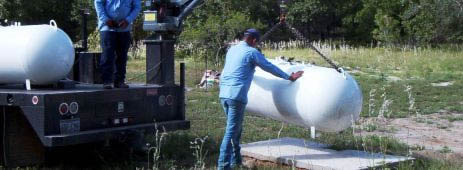
Propane Tank Installation
Propane tank installation is something that is to be performed by licensed propane companies only. Attempting to install your own propane tank is not advisable under any circumstance. Nor is it legal. See Tank Installation Estimates and Bids below for important advice before choosing what propane company installs your tank.
Tank Installation Preparation
After deciding on an appropriate tank size and before a propane tank is installed, the propane company will make all necessary arrangements for the proper placement of the propane tank. A concrete pad will need to be in place before the tank can be installed (concrete blocks may be used as an alternative). The propane company representative will ensure that all distance requirements are met and all needed permits have been applied for or are in place. Some companies will require that the trench for the yard line has been properly dug and meets code while others will dig the trench themselves. Additional resources for LP Gas tank installation decisions and preparations include:
- Propane Tank Size Selection to ensure an adequate supply of LP Gas
- Propane Tank Distance Rules that govern the installation location of ASME propane tanks
- Propane Permitting Requirements may be required by local codes and municipalities

For underground propane tanks, the propane company representative will ensure that the hole is in place and conforms to the required specifications. During new construction, where a septic system is to be installed, the propane company or homebuilder will often have the septic company dig the hole for the underground propane tank. Concerning septic tanks, the propane tank should be installed in a location that will not be in a direct path of the propane delivery truck, once installed. All too often, propane delivery bobtails will run over a septic tank and crack the lid or break through the tank lid entirely. If this happens, costly repairs are often necessary so ensure the septic tank is not a potential obstacle for propane delivery operations.
Various other preparations will be made whether the tank being installed is above or underground and the propane company rep will happily share the details of the installation as well as other installation related material facts.
The Installation Process
The beginning of the installation process will be the propane service crew arriving with the propane tank. They will often use a crane to lift and place the tank on its concrete pad, blocks, or hole (underground tanks). After the tank has been set and leveled, the installers will run the LP Gas yard line hooking each end to the gas plumbing stub out and propane tank regulator. They will then cover the trench with backfill and test the system for leaks. A delivery driver will arrive during the installation and fill the tank with propane. Following the test and safety inspection, the installers will light any pilot lights, check appliances for proper operation and review the installation with you. They will also be happy to answer any questions you may have about the tank installation, service arrangements or delivery schedules.
Propane Tank Installation Estimates and Bids
As with all construction projects, people request tank and installation bids from several different propane companies prior to making a final decision on what company is going to install the tank. This decision is primarily based on price and scheduling. Two factors that people should consider more than price is the safety record of the installing company and their business practices (reputation). Before you choose a company to install a tank, it is advisable to learn about the company's safety record and business practices. The Better Business Bureau is an excellent place to learn about a company and their practices. Each state has a regulatory agency that oversees propane and LP Gas safety. Contact your state agency governing propane safety and ask them about the safety records of your potential propane supplier. Many people that have taken this approach have found that the cheapest is not always the safest. Also see Choosing a Propane Company.
